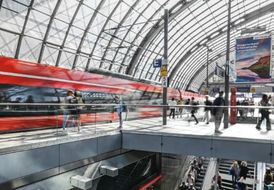Fleet development
Vehicle projects and purchases
- The ICE 1 modernization is progressing further. By the end of 2022, 18 ICE 1 trains had been modernized. Improved drive technology was implemented in parallel to the modernization in order to optimize the robustness of the drives. At the end of 2022, 42 modified multiple unit end cars were in use.
- The redesign of ICE 3 has continued. By the end of 2022, 45 multiple units had gone through the redesign. The redesign program (50 multiple units) will be completed by the second half of 2023. The long-distance trains will be given a contemporary makeover with newly designed seats, greater functionality, new colors and modern, durable materials.
- The ICE T customer program will address the most important measures to improve customer satisfaction and the marketability of the ICE T by replacing seats, partially refurbishing WCs, upgrading the vehicle interior, and carrying out repainting work by the end of 2024.
- Additional Intercity 2 double-decker trains from Alstom Transport will also be available by 2024.
- In 2020, the first nine Intercity 2 trains (KISS) were put into operation. A further eight vehicles were prepared for passenger use in 2022 and have been in use since the timetable change in December 2022.
- 22 ICE 4 trains were added in 2022. This makes the ICE 4 the largest ICE series in long-distance transport.
- In late 2022, the first four ICE 3neo trains were put into operation as planned. DB Long-Distance will put 73 ICE 3neo trains into operation by the end of 2029. The daily number of seats available for long-distance passengers will increase by 32,000 with the new trains. With this increase, we are creating the necessary capacities for a successful implementation of the Strong Rail strategy.
- The ICE L will gradually be put into operation, starting in October 2024. In a first order, 23 trains were purchased from the manufacturer Talgo. One of the features of the trains is their ground level entry at platform height.
Vehicle availability
In 2022, the vehicle availability of the ICE fleet was further improved compared with the previous year. The systematic modernization of the existing fleet has a positive effect on operational stability. The delivery of new vehicles has also contributed to an increase in vehicle availability. In order to continue the positive development, additional vehicle projects are being implemented. These include the inflow of new vehicles as well as continuous optimization measures on existing fleets, particularly with a view to expanding diagnostic capabilities.
There is also a positive development in terms of component availability in the passenger sector (for example WiFi, reservations). Despite an increase in the size of the fleet, the number of malfunctions was kept stable, thus reducing the number of multiple units used.
In order to be able to continue the good development, the findings are taken into account in addition to the above-mentioned projects, as well as in the context of newly established procurement projects such as HGV 3.0. In addition, new AI-based processes and predictive and condition-based maintenance will be used to further increase vehicle availability with existing automated systems.


